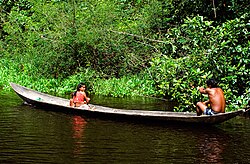Warao people
 A Warao family in their canoe A Warao family in their canoe(Photo: Roar Johansen) |
|
| Total population | |
|---|---|
| (20,000) | |
| Regions with significant populations | |
| Venezuela, Guyana, Suriname | |
| Languages | |
| Warao language | |
| Religion | |
| Traditional beliefs |
The Warao are an indigenous people inhabiting northeastern Venezuela and western Guyana. Alternate common spellings of Warao are Waroa, Guarauno, Guarao, and Warrau. The term Warao translates as "the boat people," after the Warao's lifelong and intimate connection to the water. Most of the approximately 20,000 Warao inhabit Venezuela's Orinoco Delta region, with smaller numbers in neighboring Guyana and Suriname. They speak an agglutinative language, Warao.
On the wide Orinoco River and its fertile delta composed of islands and marshes, Warao people inhabit wall-less thatched-roof huts built upon stilts for protection against floods. These houses are usually built on the highest ground to avoid the annual floods. Sometimes a group of houses is built upon a single large platform of trees. The huts each possess a clay cooking pit or oven located in the center, with sleeping hammocks encircling it. Besides the hammocks, the only other furniture sometimes present are wooden stools, sometimes carved in the shapes of animals.
Typical opensided hut on stilts.
Typical opensided hut on stilts.
Typical opensided hut on stilts.
Typical opensided hut on stilts.
Typical opensided hut on stilts.
Typical Warao canoe
Typical Warao village.
Caño Manamo. One of the major branches of the Orinoco river delta.
Warao use canoes as their main form of transportation. Other modes, such as walking, are hampered by the hundreds of streams, rivulets, marshes, and high waters created by the Orinoco. Warao babies, toddlers, and small children are famed for their ability to hold tight to their mothers' necks, as well as to paddle. They often learn to swim before they learn to walk.
The Warao use two types of canoes. Bongos, which carry up to 5 people, are built in an arduous process that starts with the search for large trees. When an old bongo is no longer usable, a consensus is reached by the male leaders of each household on which tree is best. At the start of the dry season, they find the tree and kill it. At the end of the dry season, they return to cut it down. It is then hollowed out and flattened with stone tools traded from the mountains (or local shell tools) along with fire.
...
Wikipedia
